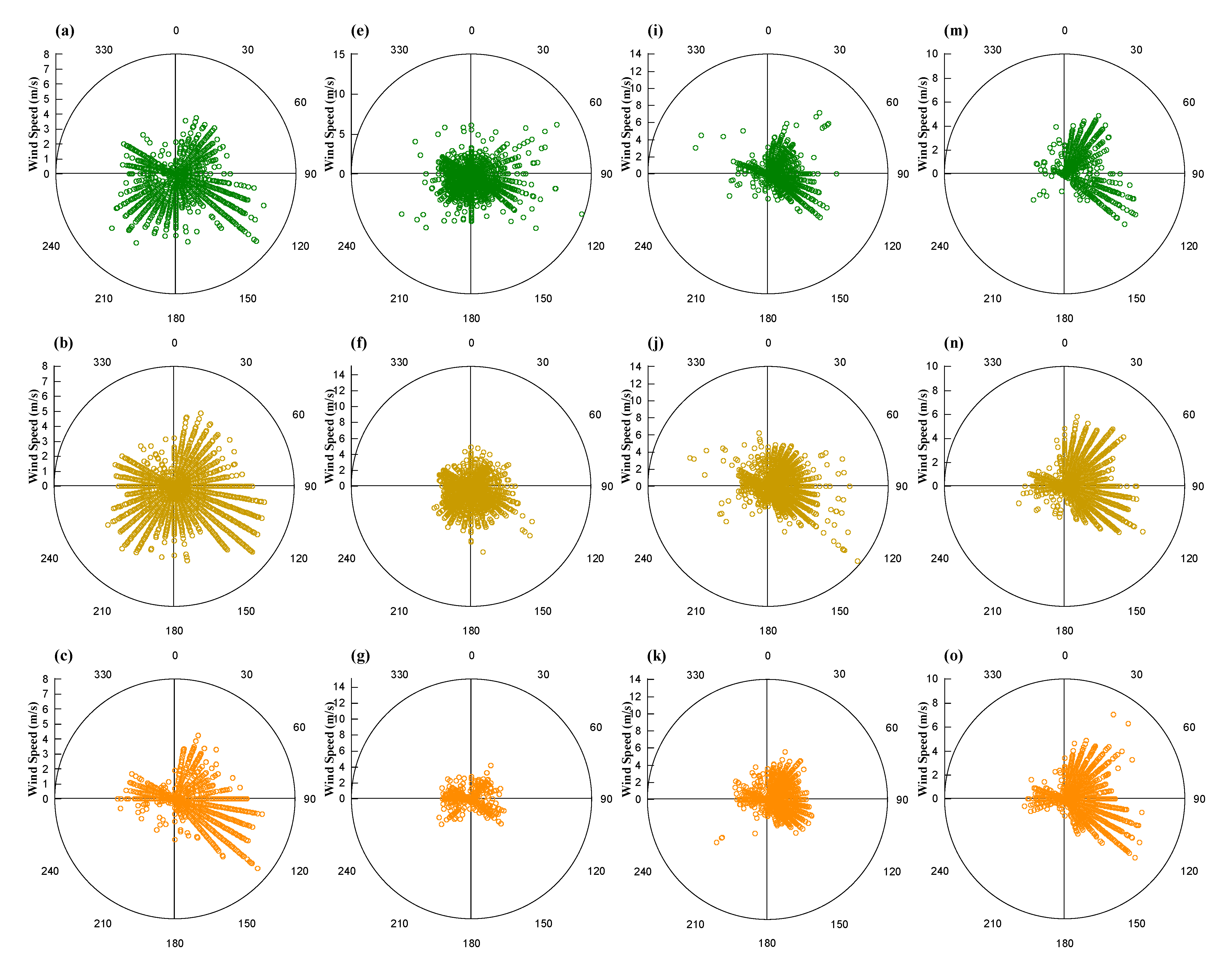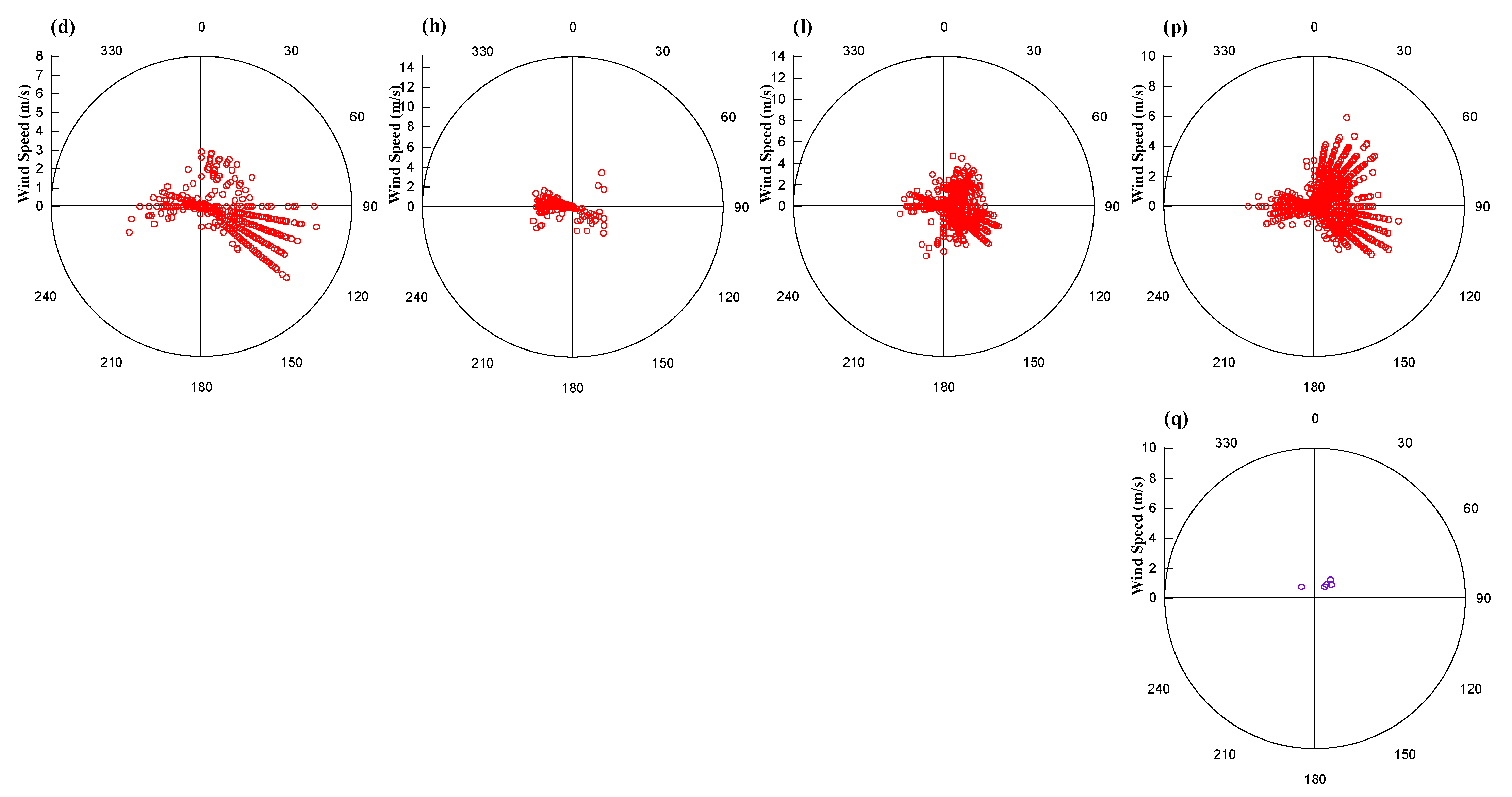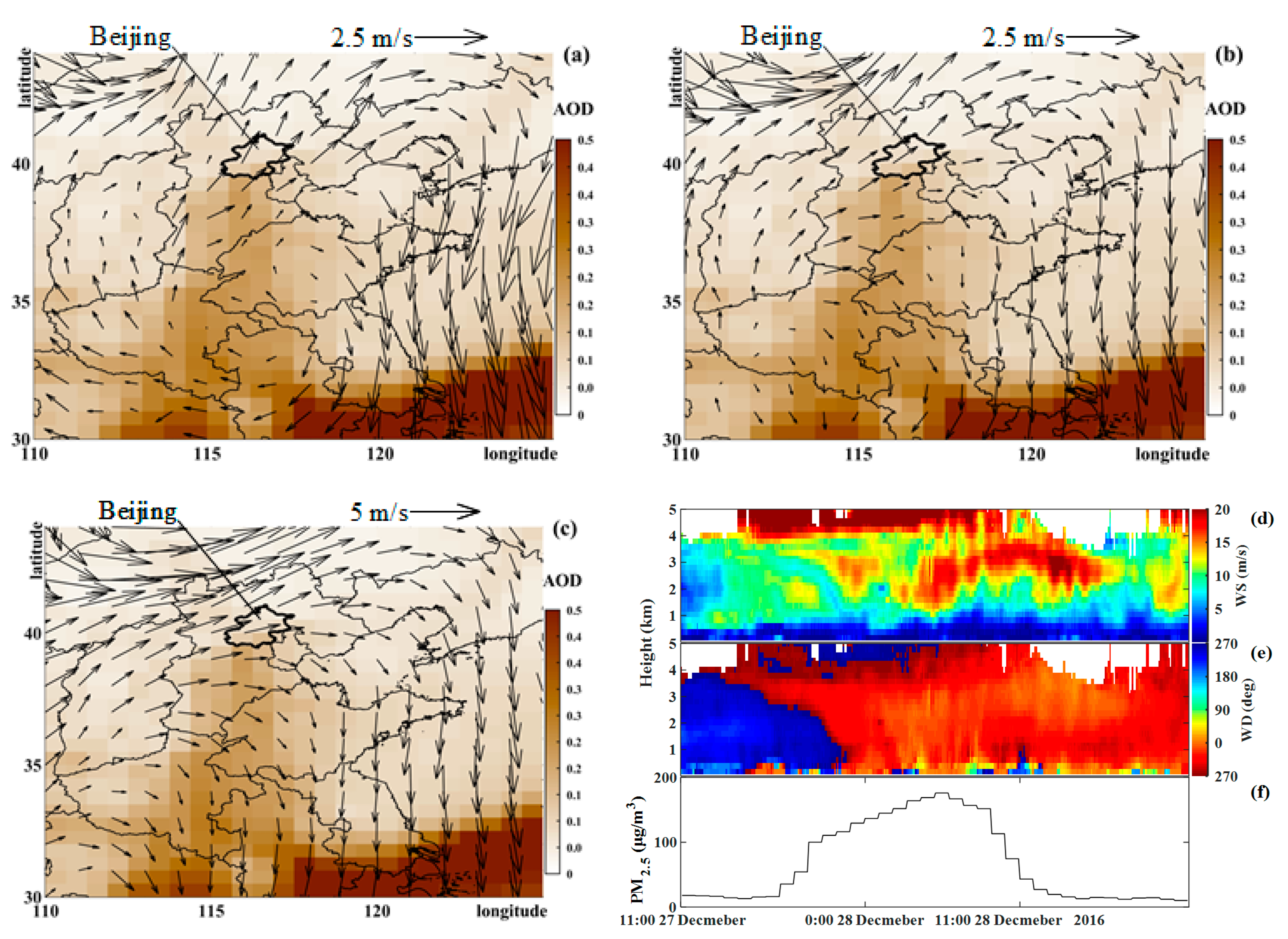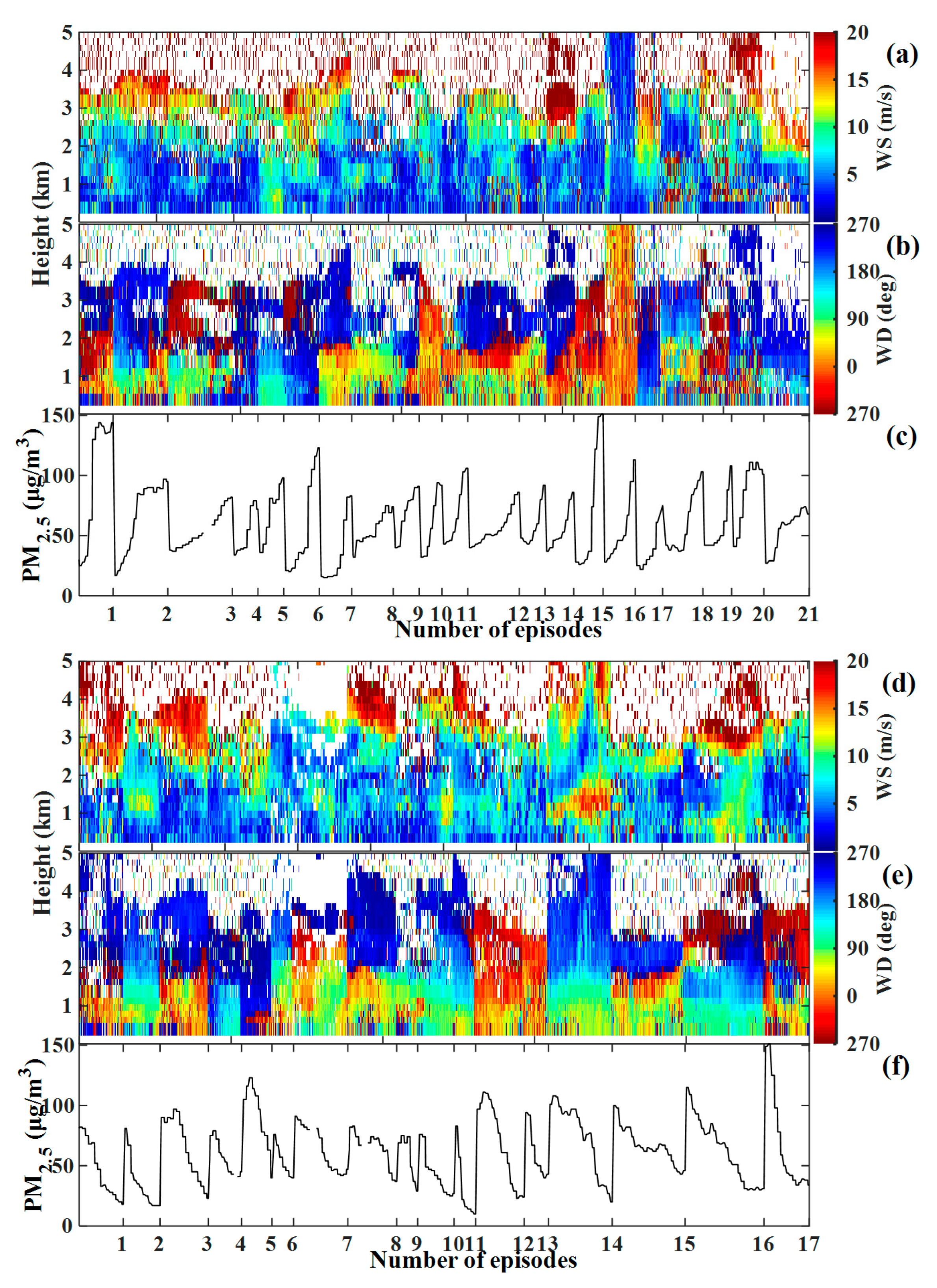Vertical Characteristics of Pollution Transport in Hong Kong and Beijing, China
Abstract
1. Introduction
2. Dataset and Methodology
3. Results and Discussion
3.1. Relationship between PM2.5 Concentration and Wind at the Surface and Higher Levels
3.2. Case Study of Vertical Profile Evolution during the Most Severe Haze Episode
3.3. Statistical Analysis of Wind Profiles during Stages of Deteriorating and Improving Air Quality
4. Conclusions
Supplementary Materials
Author Contributions
Funding
Institutional Review Board Statement
Informed Consent Statement
Data Availability Statement
Conflicts of Interest
References
- Wang, H.; Xu, J.; Zhang, M.; Yang, Y.; Shen, X.; Wang, Y.; Chen, D.; Guo, J. A study of the meteorological causes of a pro-longed and severe haze episode in January 2013 over Central-Eastern China. Atmos. Environ. 2014, 98, 146–157. [Google Scholar] [CrossRef]
- Huang, X.; Ding, A.; Wang, Z.; Ding, K.; Gao, J.; Chai, F.; Fu, C. Amplified transboundary transport of haze by aerosol–boundary layer interaction in China. Nat. Geosci. 2020, 13, 428–434. [Google Scholar] [CrossRef]
- Wang, H.; Sun, Z.; Li, H.; Gao, Y.; Wu, J.; Cheng, T. Vertical-distribution characteristics of atmospheric aerosols under different thermodynamic conditions in Beijing. Aerosol Air Qual. Res. 2018, 18, 2775–2787. [Google Scholar] [CrossRef]
- Lu, S.-J.; Wang, D.; Wang, Z.; Li, B.; Peng, Z.-R.; Li, X.-B.; Gao, Y. Investigating the role of meteorological factors in the vertical variation in PM2.5 by unmanned aerial vehicle measurement. Aerosol Air Qual. Res. 2019, 19, 1493–1507. [Google Scholar] [CrossRef]
- Zhao, D.; Tie, X.; Gao, Y.; Zhang, Q.; Tian, H.; Bi, K.; Jin, Y.; Chen, P. In-situ aircraft measurements of the vertical distribution of black carbon in the lower troposphere of Beijing, China, in the spring and summer time. Atmosphere 2015, 6, 713–731. [Google Scholar] [CrossRef]
- Tian, P.; Liu, D.; Huang, M.; Liu, Q.; Zhao, D.; Ran, L.; Deng, Z.; Wu, Y.; Fu, S.; Bi, K.; et al. The evolution of an aerosol event observed from aircraft in Beijing: An insight into regional pollution transport. Atmos. Environ. 2019, 206, 11–20. [Google Scholar] [CrossRef]
- Chan, K. Biomass burning sources and their contributions to the local air quality in Hong Kong. Sci. Total Environ. 2017, 596, 212–221. [Google Scholar] [CrossRef] [PubMed]
- Nie, W.; Wang, T.; Wang, W.; Wei, X.; Liu, Q. Atmospheric concentrations of particulate sulfate and nitrate in Hong Kong during 1995–2008: Impact of local emission and super-regional transport. Atmos. Environ. 2013, 76, 43–51. [Google Scholar] [CrossRef]
- Hagler, G.; Bergin, M.; Salmon, L.; Yu, J.Z.; Wan, E.; Zheng, M.; Zeng, L.; Kiang, C.; Zhang, Y.; Schauer, J. Local and regional anthropogenic influence on PM2.5 elements in Hong Kong. Atmos. Environ. 2007, 41, 5994–6004. [Google Scholar] [CrossRef]
- Huang, X.-F.; Yu, J.Z.; Yuan, Z.; Lau, A.K.; Louie, P.K. Source analysis of high particulate matter days in Hong Kong. Atmos. Environ. 2009, 43, 1196–1203. [Google Scholar] [CrossRef]
- Yang, X.; Zhao, C.; Zhou, L.; Li, Z.; Cribb, M.; Yang, S. Wintertime cooling and a potential connection with transported aerosols in Hong Kong during recent decades. Atmos. Res. 2018, 211, 52–61. [Google Scholar] [CrossRef]
- Li, J.; Gao, W.; Cao, L.; Xiao, Y.; Zhang, Y.; Zhao, S.; Liu, Z.; Liu, Z.; Tang, G.; Ji, D.; et al. Significant changes in autumn and winter aerosol composition and sources in Beijing from 2012 to 2018: Effects of clean air actions. Environ. Pollut. 2021, 268, 115855. [Google Scholar] [CrossRef]
- Imai, K.; Nakagawa, T.; Hashiguchid, H. Development of tropospheric wind profiler radar with Luneberg lens antenna (WPR LQ-7). Electr. Wire Cable Energy 2007, 24, 38–42. [Google Scholar]
- Tse, K.T.; Li, S.; Chan, P.; Mok, H.; Weerasuriya, A.U. Wind profile observations in tropical cyclone events using wind-profilers and doppler SODARs. J. Wind. Eng. Ind. Aerodyn. 2013, 115, 93–103. [Google Scholar] [CrossRef]
- NOAA. Wind Profiler Assessment Report and Recommendations for Future Use; National Weather Service and the Office of Oceanic and Atmospheric Research: 1994. pp. 1–141. Available online: https://ntrl.ntis.gov/NTRL/dashboard/searchResults/titleDetail/PB95131009.xhtml (accessed on 8 March 2021).
- Dibbern, J.; Engelbart, D.; Goersdorf, U.; Latham, N.; Lehmann, V.; Nash, J.; Oakley, T.; Richner, H.; Steinhagen, H. Operational Aspects of Wind Profiler Radars; Instruments and Observing Methods Report No. 79; WMO/TD No.1196; World Meteorological Organization: Geneva, Switzerland, 2003; pp. 1–92. [Google Scholar]
- World Meteorological Organization. Experience of the Japan Meteorological Agency with the Operation of Wind Profilers. Instrument and Observing Methods, Report No. 110. 2012. Available online: https://library.wmo.int/index.php?lvl=notice_display&id=13911#.YGQxrz8RVPY (accessed on 8 March 2021).
- Ishihara, M.; Kato, Y.; Abo, T.; Kobayashi, K.; Izumikawa, Y. Characteristics and performance of the operational wind profiler network of the Japan Meteorological Agency. J. Meteorol. Soc. Jpn. 2006, 84, 1085–1096. [Google Scholar] [CrossRef]
- Ma, Q.; Wu, Y.; Tao, J.; Xia, Y.; Liu, X.; Zhang, D.; Han, Z.; Zhang, X.; Zhang, R. Variations of Chemical Composition and Source Apportionment of PM2.5 during Winter Haze Episodes in Beijing. Aerosol Air Qual. Res. 2017, 17, 2791–2803. [Google Scholar] [CrossRef]
- Xing, M.; Liu, W.; Li, X.; Zhou, W.; Wang, Q.; Tian, J.; Li, X.; Tie, X.; Li, G.; Cao, J.; et al. Vapor isotopic evidence for the worsening of winter air quality by anthropogenic combustion-derived water. Proc. Natl. Acad. Sci. USA 2020, 117. [Google Scholar] [CrossRef] [PubMed]
- Du, W.; Dada, L.; Zhao, J.; Chen, X.; Daellenbach, K.R.; Xie, C.; Wang, W.; He, Y.; Cai, J.; Yao, L.; et al. A 3D study on the amplification of regional haze and particle growth by local emissions. NPJ Clim. Atmos. Sci. 2021, 4. [Google Scholar] [CrossRef]
- Cheng, Y.; Ho, K.; Lee, S.; Law, S. Seasonal and diurnal variations of PM1.0, PM2.5 and PM10 in the roadside environment of Hong Kong. China Particuology 2006, 4, 312–315. [Google Scholar] [CrossRef]
- Ding, H.; Liu, Y.; Yu, Z.; Cheung, C.; Zhan, J. Spatial and temporal characteristics and main contributing regions of high PM2.5 pollution in Hong Kong category: Observations of aerosols at mountainous, coastal, and urban measurement sites. Aerosol Air Qual. Res. 2016, 17, 2955–2965. [Google Scholar] [CrossRef]
- Lin, C.; Li, Y.; Lau, A.K.H.; Li, C.; Fung, J.C.H. 15-Year PM2.5 trends in the Pearl River Delta region and Hong Kong from satellite observation. Aerosol Air Qual. Res. 2018, 18, 1680–8584. [Google Scholar] [CrossRef]








| Air Qality | Air Quality Category 1 | Air Quality Category 2 | Air Quality Category 3 | Air Quality Category 4 | Air Quality Category 5 | Air Quality Category 6 | |
|---|---|---|---|---|---|---|---|
| Station & Season | |||||||
| PM2.5 health effects statement according to U.S. EPA | PM2.5 air pollution poses little or no risk | Unusually sensitive individuals may experience respiratory symptoms | An increasing likelihood of respiratory symptoms in sensitive individuals, aggravation of heart or lung disease, and premature mortality in persons with cardiopulmonary disease and the elderly | Increased aggravation of heart or lung disease and premature mortality in persons with cardiopulmonary disease and the elderly; increased respiratory effects in the general population | Significant aggravation of heart or lung disease and premature mortality in persons with cardiopulmonary disease and the elderly; a significant increase in respiratory effects in the general population | Serious aggravation of heart or lung disease and premature mortality in persons with cardiopulmonary disease and the elderly; serious risk of respiratory effects in the general population | |
| PM2.5 concentration: μg/m3 | 0.0–12.0 | 12.1–35.4 | 35.5–55.4 | 55.5–150.4 | 150.5–250.4 | 250.5–500.4 | |
| Tap Mun Station | spring | 6305 | 21,954 | 7733 | 2734 | 15 | 0 |
| summer | 18609 | 12,317 | 1773 | 1074 | 12 | 0 | |
| autumn | 3788 | 16,277 | 9066 | 5631 | 21 | 0 | |
| winter | 1742 | 14,405 | 11,226 | 7592 | 34 | 0 | |
| Sha Tin Station | spring | 3176 | 7417 | 1403 | 268 | 1 | 0 |
| summer | 7614 | 3382 | 540 | 233 | 0 | 0 | |
| autumn | 2490 | 6768 | 2434 | 867 | 0 | 0 | |
| winter | 1182 | 6574 | 3259 | 2051 | 18 | 0 | |
| Sham Shui Po Station | spring | 1614 | 9246 | 3030 | 687 | 0 | 0 |
| summer | 4810 | 6895 | 690 | 290 | 0 | 0 | |
| autumn | 1613 | 8179 | 3452 | 937 | 0 | 0 | |
| winter | 903 | 7308 | 4349 | 1958 | 5 | 0 | |
| Altitude | 315–720 m | 923–1732 m | |
|---|---|---|---|
| Air Quality Category | |||
| Level 1 | 12,685 | 22,308 | |
| Level 2 | 107,322 | 181,213 | |
| Level 3 | 72,906 | 120,746 | |
| Level 4 | 34,781 | 55,955 | |
Publisher’s Note: MDPI stays neutral with regard to jurisdictional claims in published maps and institutional affiliations. |
© 2021 by the authors. Licensee MDPI, Basel, Switzerland. This article is an open access article distributed under the terms and conditions of the Creative Commons Attribution (CC BY) license (https://creativecommons.org/licenses/by/4.0/).
Share and Cite
Yang, X.; Qian, W.; Gong, D.; Zhao, C.; Chan, P.-w.; Zhou, W.; Huang, Y.; Zhang, F.; Li, Z. Vertical Characteristics of Pollution Transport in Hong Kong and Beijing, China. Atmosphere 2021, 12, 457. https://doi.org/10.3390/atmos12040457
Yang X, Qian W, Gong D, Zhao C, Chan P-w, Zhou W, Huang Y, Zhang F, Li Z. Vertical Characteristics of Pollution Transport in Hong Kong and Beijing, China. Atmosphere. 2021; 12(4):457. https://doi.org/10.3390/atmos12040457
Chicago/Turabian StyleYang, Xin, Wei Qian, Daoyi Gong, Chuanfeng Zhao, Pak-wai Chan, Wei Zhou, Yu Huang, Fang Zhang, and Zhigang Li. 2021. "Vertical Characteristics of Pollution Transport in Hong Kong and Beijing, China" Atmosphere 12, no. 4: 457. https://doi.org/10.3390/atmos12040457
APA StyleYang, X., Qian, W., Gong, D., Zhao, C., Chan, P.-w., Zhou, W., Huang, Y., Zhang, F., & Li, Z. (2021). Vertical Characteristics of Pollution Transport in Hong Kong and Beijing, China. Atmosphere, 12(4), 457. https://doi.org/10.3390/atmos12040457









